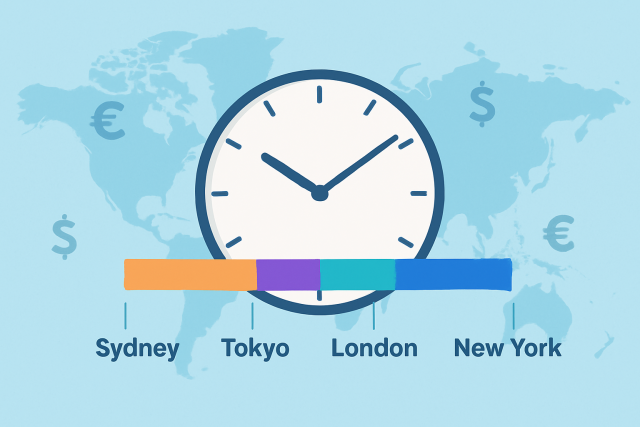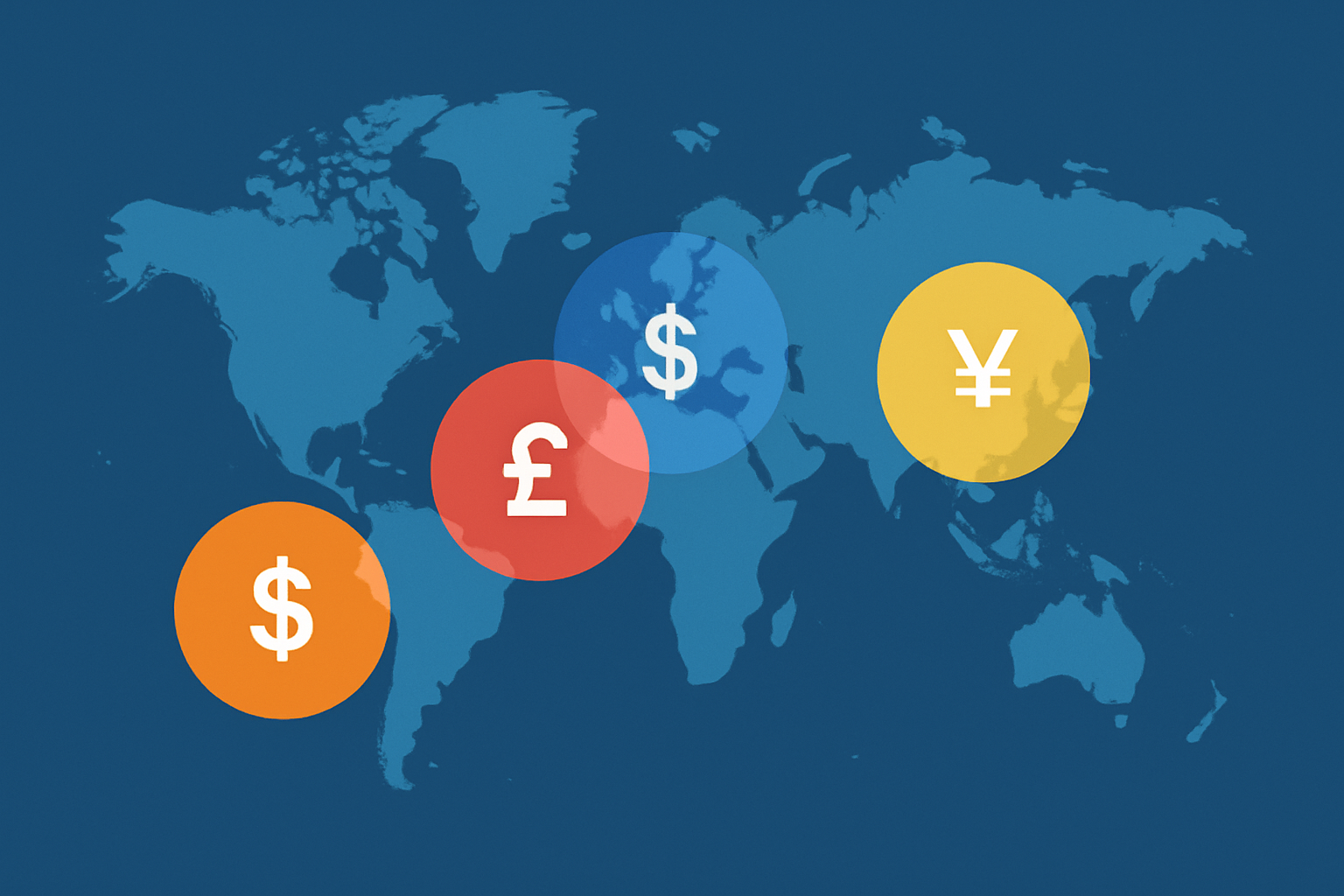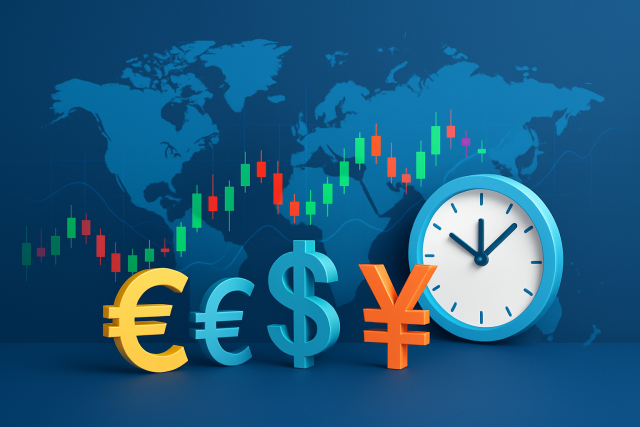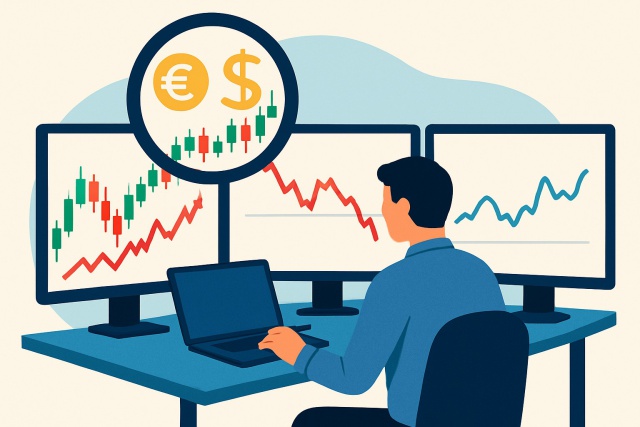
What is the Forex Market Opening Hours?
Discover how forex market opening hours shape trading strategies worldwide. Learn the key sessions,...

Understanding forex currency trading times is crucial since the forex market operates around the clock across various financial hubs worldwide. It's important for traders to have a solid grasp of the precise trading hours for each market. Knowing when different currency markets swing open can help you pounce on periods packed with high liquidity and volatility. Those golden hours often translate into smarter, more rewarding trades.
Forex market sessions are key windows when major financial hubs around the globe come alive and start buzzing with trading activity. Each session plays a big role in shaping market volatility and liquidity and sometimes makes the difference between a calm day and a rollercoaster ride. The four main players here are Sydney, Tokyo, London and New York.
Each major forex market session tends to carry its own unique vibe shaped by the rhythms of regional economic activity. Sydney kicks things off with fairly low liquidity, almost like the calm before the storm. Then Tokyo chimes in, adding a flavor of Asian market factors that quietly start to stir the pot. London usually steals the show with the highest volume and some seriously strong volatility it’s where the action really picks up.
| Market Session | Time (GMT/Local) | Major Currency Pairs Active | Typical Volatility Level | Regional Economic Influences |
|---|---|---|---|---|
| Sydney | 10:00 PM - 7:00 AM GMT | AUD/USD, NZD/USD, Asia-Pacific pairs | Usually low to moderate | Economic updates from Australia and New Zealand that tend to set the tone for the day ahead |
| Tokyo | 12:00 AM - 9:00 AM GMT | USD/JPY, EUR/JPY, Asian cross pairs | Moderate volatility | Japanese industrial figures and Asian market trends often keep traders on their toes |
| London | 8:00 AM - 5:00 PM GMT | EUR/USD, GBP/USD, USD/CHF, EUR/GBP | Generally high | UK economic data and ECB decisions make this session the real hotspot for action |
| New York | 1:00 PM - 10:00 PM GMT | USD/CAD, USD/JPY, GBP/USD, EUR/USD | Typically high | US labor reports and Federal Reserve announcements usually bring fireworks to the market |
When it comes to navigating the bustling world of forex trading, timing really is everything. The currency markets never sleep, and knowing when the action peaks can make all the difference. So, let us break down those important forex currency trading times and get you ahead of the game.
The Sydney forex market kicks off at 10 PM GMT and wraps up at 7 AM GMT. It’s the very first major financial hub to jump into the trading day, with the Australian dollar (AUD) and New Zealand dollar (NZD) generally stealing the spotlight during these hours.
A bustling hub where the action kicks off while many of us in the West are still rubbing the sleep from our eyes. It’s the perfect time to catch some fresh opportunities, especially if you’re an early bird who likes to jump in when the market is waking up. Keep in mind, these hours can be a game-changer for your trading strategy, blending the quiet of night with bursts of activity that can make for some exciting moves. So grab your coffee and get ready, because when Tokyo’s lights flicker on, the Forex stage comes alive in a way that’s pretty unique.
The Tokyo session runs from 12 AM to 9 AM GMT and often kicks off with a noticeable buzz around Japanese yen (JPY) pairs like USD/JPY and EUR/JPY. It pretty much sets the stage for Asian market trends and reacts to key economic data coming out of Japan and its neighbors.
The London session is the biggest and most lively stretch in the forex trading day, running from 8 AM to 5 PM GMT. It is the time when trading volumes crank up and volatility picks up, especially with heavy hitters like EUR/USD, GBP/USD and USD/CHF. Economic reports from the UK and Europe often shake things up during these hours and lead to significant price moves.
When it comes to the bustling Forex market, New York usually steals the spotlight. It’s where the action really ramps up. Traders often find themselves glued to screens from morning until close of business as the city that never sleeps surely keeps the financial world buzzing.
Running from 1 PM to 10 PM GMT, the New York session often overlaps with London’s closing hours. This sweet spot usually cranks up trading volumes and amps up volatility, especially in USD pairs like USD/CAD and USD/JPY.

Global forex trading sessions map showing the time zones and overlapping market hours for Sydney, Tokyo, London, and New York.
Overlap periods between forex sessions usually turn out to be the busiest—and often the most rewarding—times for traders. These windows bring together high liquidity from various markets, which more often than not sparks quicker price moves and tighter spreads.
Currency pairs often dance to the beat of their main market sessions. Take AUD and NZD pairs for instance they usually show more action during the Sydney session, while JPY pairs tend to wake up and get moving once Tokyo opens its doors. Over in Europe, EUR and GBP pairs often turn up the heat with their highest volatility during London hours. Meanwhile, USD pairs typically steal the spotlight in the New York session.
| Currency Pair | Main Market Session | Typical Volatility | Best Trading Hours |
|---|---|---|---|
| AUD/USD | Sydney | Moderate | 10 PM - 7 AM GMT – when the Aussie market wakes up and the world still sleeps |
| USD/JPY | Tokyo | Moderate to High | 12 AM - 9 AM GMT – watch out for those early morning moves, they can surprise you |
| EUR/USD | London | High | 8 AM - 5 PM GMT – prime time for action, when London’s hustle really kicks in |
| GBP/USD | London | High | 8 AM - 5 PM GMT – same story as EUR/USD, the city never fails to bring the heat |
| USD/CAD | New York | High | 1 PM - 10 PM GMT – New York’s window, where things can get pretty lively without warning |
| NZD/USD | Sydney | Moderate | 10 PM - 7 AM GMT – quiet but steady, perfect if you like a calmer ride |
| EUR/JPY | Tokyo/London | Moderate to High | 7 AM - 9 AM & 8 AM - 5 PM GMT – the bridge between Asia and Europe, catching waves from both shores |
Traders often boost their efficiency by tweaking strategies to fit the ebb and flow of forex trading hours. They focus on the busiest times and dodge the slow patches that can quietly rack up costs. They take advantage of the typical swings in volatility to time their entries and exits like seasoned pros.
Take a close look at the active hours for your favorite currency pairs. This is when volatility and liquidity usually peak and you get a better sense of when the action heats up.
Focus your trading around golden overlap times like the London-New York window. During these periods liquidity is high, spreads get tight and orders flow smoothly.
Avoid low volume periods because they often cause slippage and wider spreads that can reduce your profits.
Keep an eye on economic calendars for upcoming events that could impact the market sessions you are involved in. This way you won’t be caught off guard by sudden volatility.
Adjust your strategies throughout the year since holidays and daylight saving changes can disrupt session times and trading volume. Small tweaks can make a big difference.
Use limit and stop orders wisely to help manage risk especially around the often unpredictable session openings and closings when things can get jumpy.
Aligning your trading schedule with the main forex market sessions can really boost your chances of catching those price moves just right, all while helping to steer clear of the usual pitfalls tied to low liquidity periods. – Professional Forex Trader
There are plenty of handy tools out there to help traders track forex currency trading times across different market sessions. Forex market hours converters make it a breeze to flip times into your local timezone, while world clocks offer a real-time peek at session action. Economic calendars nudge you with heads-ups about important upcoming data releases during the busiest sessions, and alert systems keep you in the loop on potential bursts of volatility.
20 articles published
Transforming the field of forex trading through his systematic approach to currency pair analysis, he focuses on macroeconomic indicators and central bank policy impacts.
Read Posts
Discover how forex market opening hours shape trading strategies worldwide. Learn the key sessions,...

New to forex? Discover essential insights, risks, and strategies in this beginner-friendly guide to...

Leverage in forex allows traders to amplify their market exposure with limited capital. Understand h...

Leverage in forex lets traders control bigger positions with less capital. Learn how it works, its r...
27 articles published
23 articles published
20 articles published
